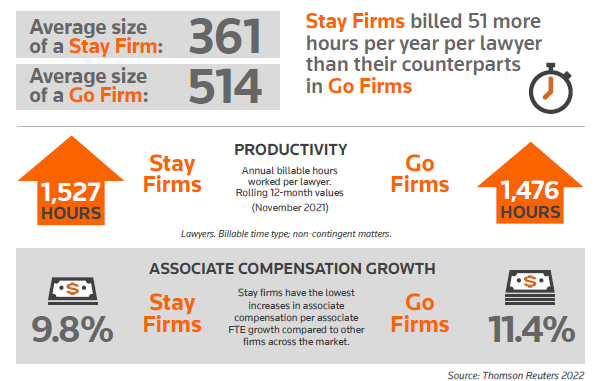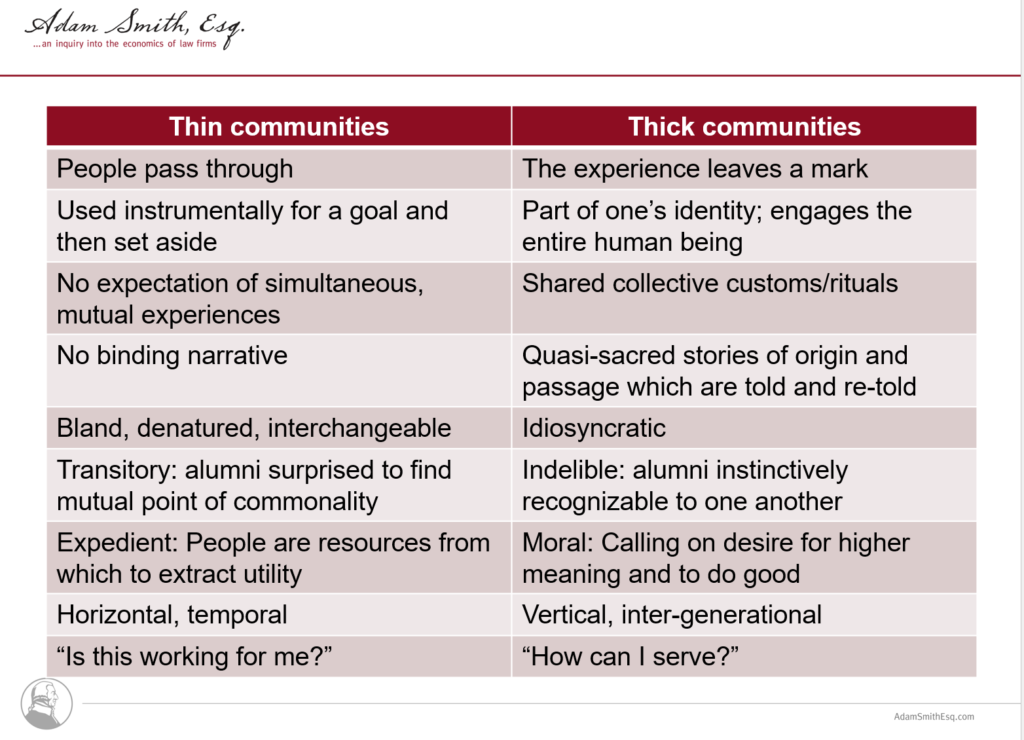Even more perverse, at first glance, are these numbers from Thomson Reuters’ most recent (2022) annual must-read, the State of the Legal Market Report. (They disclaim the numbers as “preliminary,” but it’s difficult to imagine the final figures turning these indications completely on their heads.)
Some notes on the terminology:
- “Stay” firms are the lowest quartile in the sample for annual turnover at 8.7% and “Go” firms are the highest quartile at 18.4%.
- Lawyers at Stay firms billed almost 4% more hours than at their Go peers.
- And, most counterintuitively, Stay firms increased compensation at a slightly lower rate than Go firms.
Whatever the final figures (due out in late spring) reveal, the evidence seems to confirm that some factor or combination of factors makes lawyers “stickier” at their firms than compensation per se.
Maybe the true surprise with this compensation/attrition disconnect is that we are surprised. We should know better than to think compensation per se makes people satisfied, happy, and loyal.
A quick survey of some of the copious literature on “what contributes to job satisfaction” shows the top five-plus slots occupied by factors such as:
- autonomy,
- flexibility and work-life balance
- intellectual challenge
- the opportunity for and the reality of professional growth
- camaraderie with colleagues
- belief in the culture and values of the organization
- high quality senior leadership
- promotion/advancement opportunities at the firm
- being appreciated for what you do
- job security and consistent strong financial performance by the firm.
This litany has one compelling salient characteristic for purposes of our discussion today: It has the undeniable ring of truth, the arrows hitting the bullseye. Those are the reasons I go to work; aren’t they yours?
Did you note what’s not on the list? An attractive salary.
Indeed, compensation per se ranks as “one of the three [motivators] at the bottom of the list” (GlassDoor, “Which workplace factors drive employee satisfaction around the world?”), eighth out of ten (SuccessStream, “What factors contribute to job satisfaction? The top 10”), eighth out of ten (Forbes, various articles), and seventh to ninth out of ten (multiple psychological studies).
In other words, a “fair” market-rate salary is not a compelling motivation; put in the framework of Maslow’s hierarchy, once it’s satisfied it becomes background, part of your assumed mental furniture. (Thought experiment: No one in a job interview would dream of asking, “Do you plan on paying me a fair salary?” Might as well ask, “Are your offices heated?” It’s a given. By contrast, however, a candidate might well ask what opportunities there are for advancement, or what the firm stands for or is most proud of.)
The problem with analyzing those high-priority motivators as presented is that it is here—and almost universally—compiled as if it were a random shopping list, with no unifying theme: Some things from the supermarket, something else at the hardware store, an item from the drugstore, etc.
And it’s tough to identify a unifying theme.
Which brings us to “thick” and “thin” communities.
This concept has been around for awhile, but seems to have lived in relative obscurity. It deserves a wider audience.
The core insight behind imagining a spectrum of communities running from “thick” to “thin” is to expose and begin to describe the massive difference we feel behind some communities we belong to and others.
We behave towards some (and they towards us) in terms of transactional patterns: Quid pro quo, money for value, a fair bargain, “have a nice day” and “see you around [never],” etc. But towards other communities, we don’t “behave” as such: We relate.
This distinction–and the ensuing behavioral dynamic–I submit, is precisely what we see at play in the Great Associate Attrition/Comp Wars of 2022. How could it possibly be that workload is evidently wholly uncorrelated with attrition, if it’s overwork that’s killing us? And how could it possibly be that firms raising comp at the fastest rate fare no better at all in retention than their lagging-behind peers?
If it’s not the “thick/thin” community dynamic at work, I am flat out of hypotheses.
But first, let’s shed a bit more light on what we mean by thick/thin. Here’s a highly condensed table we developed to describe and display the differences between the two:
This makes it all come together, no?
If your firm is experienced as a Thin community for its lawyers, $1.00 less than the going rate is notable, grating, and motivating.
If it’s a lived Thick experience, compensation stays—so long as fair, remember!—a tertiary consideration and leagues from a motivator.
And don’t you want your workplace to be a “thick” experience? I certainly do. Sharing a cause, a mission larger than yourself, a sense of challenges overcome and intellectual growth flourishing in rich soil, all while serving clients superbly and with a je ne sais quoi flair. Above all, a place one can be proud of belonging to. Versus punching the hourly clock, work as an unavoidable evil if you want food on the table and a roof over your head.
Many of you reading this are in positions of leadership at your firm that give you a hand in envisioning and building the connecting tissues and flesh of a genuinely lived thick community. And the good news is that for the 99% of you not at a global elite firm, creating and sustaining that community costs no more than skating over the surface of a thin community. Actually cheaper if you think attrition entails financial cost (it does).
So here, perhaps, we have found a pearl in the gritty oyster bed of the associate attrition/compensation treadmill. You don’t have to believe all the following postulates, but try them on for a moment:
- Extreme rates of associate attrition are expensive in sheer financial terms, in terms of degraded and disrupted client service, and eat away at the firm’s precious social capital.
- The compensation arms’ race is on an unsustainable course.
- Talent is our stock in trade; it’s why clients come to us and not the other guys.
- Highly pedigreed professionals do their best work when they bring both head and heart, intellect and passion, to the tasks in front of them.
Even if you just subscribe to just one or two of these, why not try moving towards, or more deeply into, this virtual circle: An inspired and believing community outperforms its perfunctory shadow self–every time. Its economics can’t be beat in the long run. And it’s where smart and capable human beings want to live and work.
You know what to do.
Or if you don’t, just ask






Bruce:
Your contrast of “thick” and “thin” communities has the ring of something that is both true and helpful. It fits naturally with thick communities be comprised of members, whereas thin communities would be comprised of employees, in the sense of persons who are being employed, that is used. One of my hobbyhorses is stewardship as a concept that relates members to thick communities on a voluntary basis that evolves through time and practice into habits of the heart and mind. Very well done.
Mark:
Thanks as always for a thoughtful and insightful observation. The concept of “thick/thin” communities has been with me for along time and like one of those (as you saw at once!) concepts that is both useful and intuitively spot-on, I knew it would come in handy at some point in the context of ASE subject matter. I hope to have contributed a bit of insight into a too-oft neglected dimension of the lived experience in BigLaw.